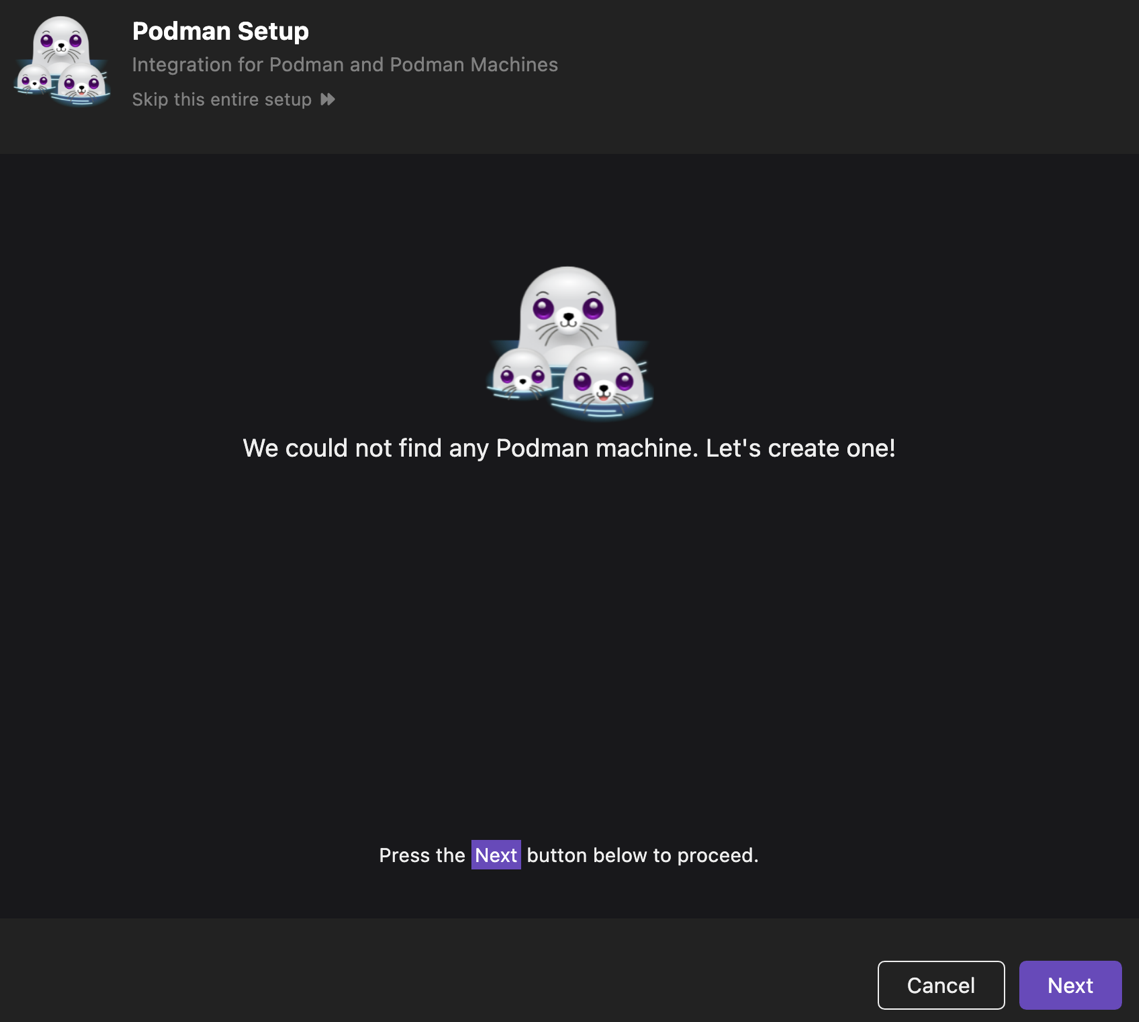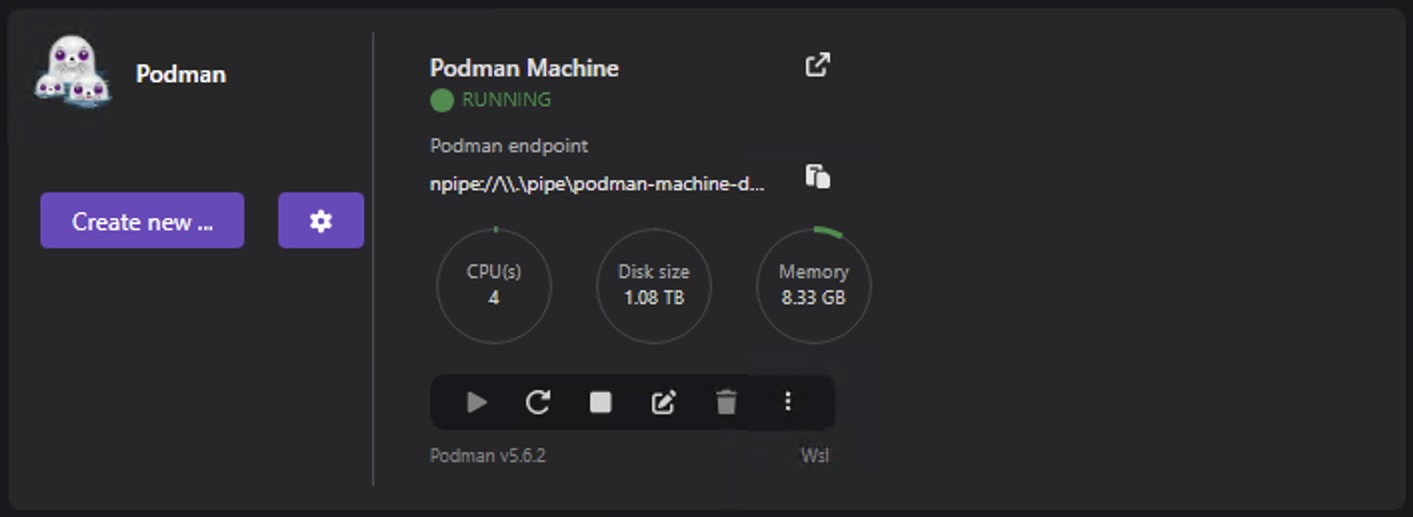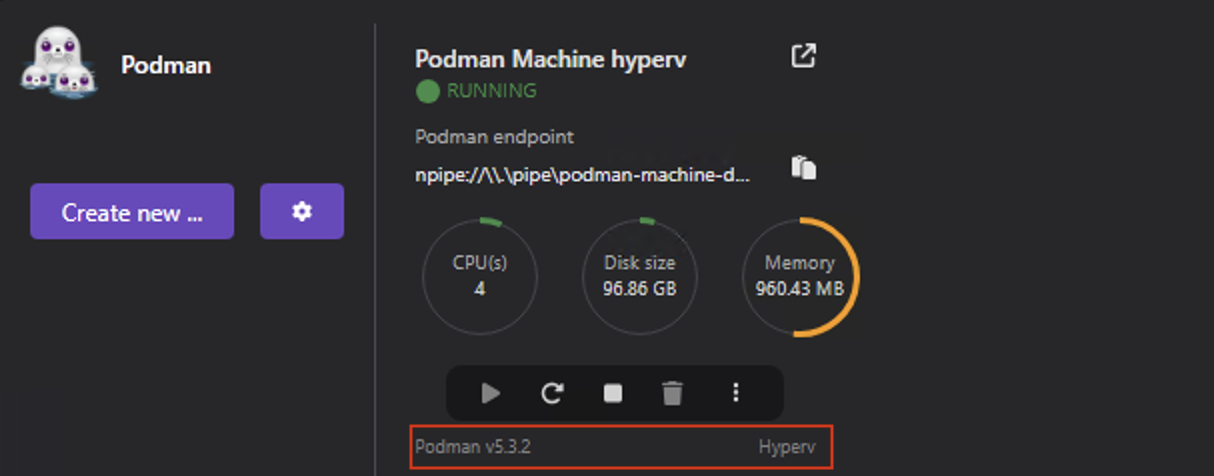Installing Podman Desktop and Podman on Windows
You can install Podman Desktop by using:
- The Windows installer
- Windows Package Manager (WinGet)
- Other alternative methods
During Podman installation, ensure to have administrator privileges for the following tasks:
- Installing or updating Windows Subsystem for Linux version 2 (WSL 2) on a single-user or all-users machine
- Enabling the WSL feature to allow users to set up Podman
- Setting up a Podman machine using Hyper-V as the machine provider type
Installing Podman Desktop
Using the Windows installer
- Download the Windows installer.
- Locate the file in the Downloads folder, and double-click on it. The Podman Desktop Setup screen opens.
- Select one of the installation options:
Windows Linux Subsystem (WSLv2)orWindows Hyper-V. - Click Install. Wait for the installation to complete.

- Click Finish to close the screen. The Get started with Podman Desktop screen opens.
Using WinGet
-
Install from the terminal:
> winget install RedHat.Podman-Desktop
Alternate installation methods:
- Silent Windows installer
- Chocolatey
- Scoop
Silent Windows installer
-
To install without user interaction, run the Windows installer with the silent flag
/Sfrom the Command Prompt:> podman-desktop-1.6.4-setup-x64.exe /S
Chocolatey
-
Install the Chocolatey package manager.
-
Install from the terminal:
> choco install podman-desktop
Scoop package manager for Windows
-
Install from the terminal:
> scoop bucket add extras
> scoop install podman-desktop
Installing Podman
On Windows, running the Podman container engine requires running a Linux distribution on a virtual machine.
Use WSL2 as machine provider
Podman Desktop creates a Windows Subsystem for Linux version 2 (WSL 2) virtual machine: the Podman Machine.
Main benefits are:
- Ease of use.
- WSL 2 native virtualization performance.
Prerequisites
Check that your environment has:
- 6 GB RAM for the Podman Machine.
- Windows Subsystem for Linux version 2 (WSL 2) prerequisites. See Enabling WSL 2, WSL basic commands, and Troubleshooting WSL 2:
- The Windows user has administrator privileges.
- Windows 64bit.
- Windows 10 Build 19043 or greater, or Windows 11.
- On a virtual machine: Nested Virtualization enabled.
Procedure: Enable the WSL feature
-
Open the command prompt, and run the following commands to enable the WSL feature without installing the default Ubuntu distribution of Linux.
> wsl --update
> wsl --install --no-distributionnoteIf you run the Podman Desktop setup on a Windows 10 LTSC version, you require to install a specific WSL distribution. See Troubleshooting Podman on Windows
-
Restart your computer.
Procedure: Install Podman Desktop dependencies
After installing Podman Desktop, the Get started with Podman Desktop screen opens to help you start onboarding. You can install Podman, kubectl CLI and compose CLI or completely skip this onboarding setup and do it later by using:
- The Set up button shown in the notification on the Dashboard page.
- The Setup Podman button shown in the Podman tile on the Resources page.
Perform the following procedure to set up Podman and create the Podman machine:
- Click Set up in the notification on the Dashboard page.

- Click Next. A confirmation notification to install Podman opens.
- Click Yes. The Podman Setup screen opens with the default WSLv2 virtualization provider selected.
- Click Install. A notification stating
Installation Successfully Completedappears on the screen.
- Click Close. A page notifying that Podman has been set up correctly opens.
- Click Next. A page notifying you to create a Podman machine opens.
- Click Next, and then click Create.

- Click Next to navigate back to the Dashboard page.
To verify that Podman is set up, go to Settings > Resources and view the running Podman machine in the Podman tile.

You are now ready to use the application.
Use Hyper-V as machine provider
As an administrator, you can set up a Podman machine using Hyper-V as the machine provider type. To do so, select hyperv from the Provider Type dropdown list when creating a Podman machine.
If you already have a running Podman machine with the WSL provider type, you will be prompted to set the Hyper-V machine as the default machine to avoid CLI errors.
Verification
- Go to Settings > Resources.
- View the created machine in the Podman tile.
